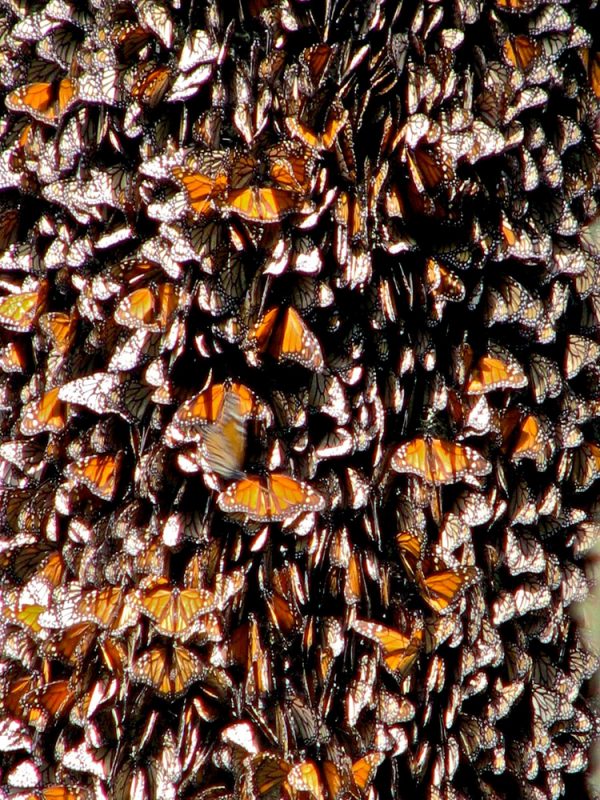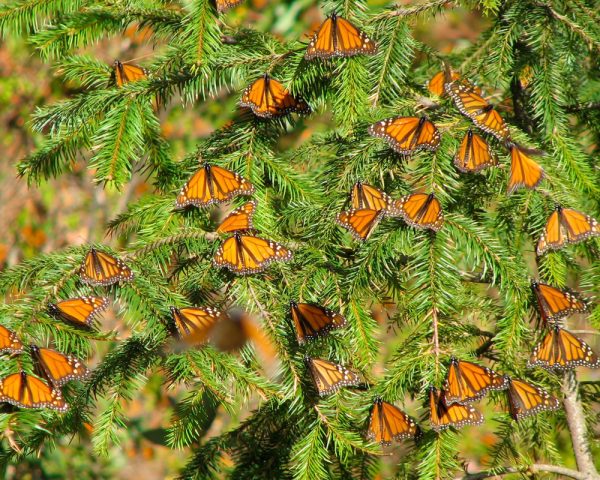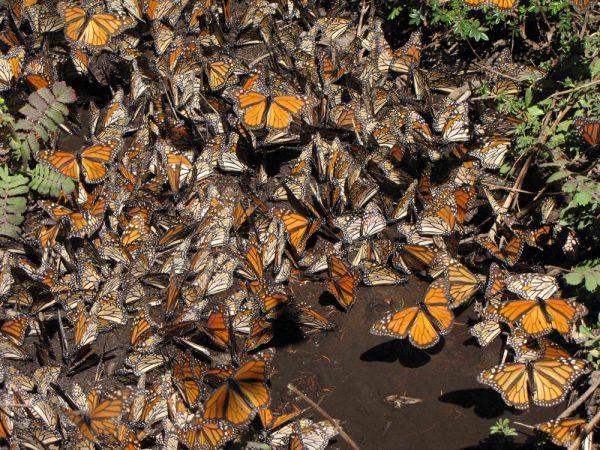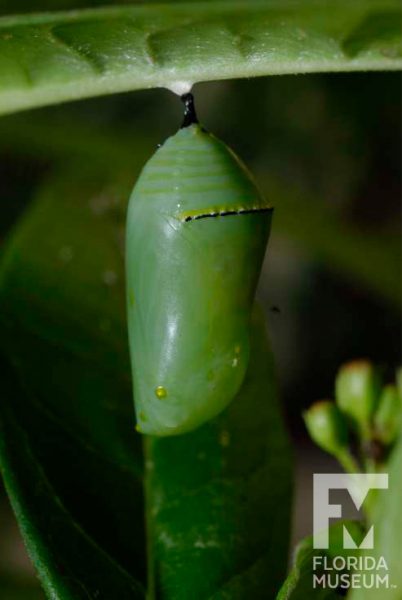Imagine walking into a towering cathedral draped with million-faceted curtains of orange-gold and black, shimmering in the morning sunlight. Then these incredible living tapestries take flight, with a soft rustle from countless wings sweeping the air and billions of tiny butterfly scales drifting downward in a golden shower. The only sounds in nature’s orchestra: the swaying oyamel fir trees, butterfly-laden boughs gently brushing the air, punctuated solely by the hushed gasps of amazement coming from your companions at 10,500 feet in the mountains of southern Mexico.
One of the greatest wildlife spectacles on earth takes place every winter, as more than 1 billion Monarchs move across the entire eastern United States and Canada to a tiny spot in the transvolcanic range west of Mexico City. Flying as much as 2,500 miles to a dozen tiny colony sites, these butterflies are performing a miracle that they’ve repeated annually for the past 30,000 years and perhaps far longer.

Florida Museum photo by Court Whelan
While a host of scientific questions remain to be answered, and the butterfly’s migration teeters on the very edge of survival due to a host of factors affecting its conservation, we now have a good perspective on the overall migration phenomenon and how it may best be preserved for future generations to enjoy.
The Monarch story starts with a tiny egg, laid in the late spring by the northward-flying, overwintering butterflies when they reach the southern boundary of the United States. Hatching quickly, with each larva passing through five stages (or instars) in several weeks, the first generation of larvae pupates and emerges as new adults by the end of April. This first annual generation then continues the northward movement, flying hundreds of miles (with mating and laying of eggs) to the north. The second generation quickly follows in May and June, with the new adults flying still further north. A third generation at midsummer makes it all the way to the northern tier of states and southern Canada, often with time to initiate a fourth generation before the weather turns around at the beginning of fall. In September, regardless of their location on the continent, these adult monarchs of the last two summer generations take flight to the south. Moving as individuals or small groups, they fly day after day in a steady stream southward, from the first part of September to as late as mid November, flying over land and water, desert and mountain, to reach their goal of the overwintering sites in Mexico.

Florida Museum photo by Court Whelan
How do they make this incredible journey in just two and a half months? Many scientists now believe that several navigational abilities and sensory systems are involved. Monarch butterflies probably first utilize a sun compass that allows them to navigate by maintaining a particular compass direction in relation to the polarized light entering the atmosphere from the sun.
This orientation by a sun compass to reach the general vicinity of central Mexico may well be enhanced by the potential ability of the Monarch to track natural variations in the earth’s magnetic field. Douglas S. Jones (now director of the Florida Museum) and Bruce J. MacFadden (now curator of vertebrate paleontology at the Florida Museum) pioneered investigations of the magnetic ability of butterflies, in particular the Monarch, with their work from 1982-85, where they showed that the thorax and head of the Monarch contain important concentrations of magnetite, a magnetic material the butterfly produces during the pupal stage.

Florida Museum photo by Court Whelan
Magnetite is used in orientation and navigation by other organisms such as birds and moths, so the Jones and MacFadden work stimulated other scientists to test migrating Monarchs for responses to powerful magnets. When placed in a large outdoor cage, migrating Monarchs have their direction of travel switched strongly, even totally reversed, by movement of the magnetic fields. Since there are strong local magnetic anomalies in the Trans Volcanic Range, caused by heavy metals being brought to the surface in old volcanic vents, it is possible that the butterflies are using variations in the earth’s magnetic field to reach sites that their ancestors flew to the previous year.
Other work done at the University of Florida and in England has shown that Monarchs produce an extraordinary array of chemicals for predator defense. Pyrazines, for example, are chemical components of the strong warning odor that Monarchs emit naturally and it can be sensed by potential predators before they bite the butterfly. It is quite possible that the billions of scales left behind each year on the overwintering trees and the bodies in the soil, can be detected by the sensitive chemical stimuli-receiving organs on the Monarch’s antennae and feet, which could help the grandchildren and great-grandchildren of the previous year’s migrants arrive unerringly on the same trees and slopes that their ancestors left the previous spring.

Florida Museum photo by Eric Zamora
As regular as a thermometer, the colony must move up and down during the months on site to maintain a constant exposure to temperatures just above freezing and yet not be exposed to temperatures so warm as to exhaust their fat reserves before spring. There are many flowers in bloom at these elevations, even in January, but relatively few of the Monarchs feed during the winter and biologists believe that this observed nectar feeding is a relatively minor need for the colonies as a whole. Indeed, the vast majority of the butterflies hang on the trees day and night in great clumps, piled 10-20 butterflies deep, each clinging for dear life on the one below with its legs, two tiny hook-like tarsal claws at the end of each leg grasping the next butterfly’s wing edges or body.
The main enemy of the Monarch colonies today is man. In the past few decades, rampant logging has taken place, even illegal cutting inside the existing Monarch reserves. The rate of timber loss has become so alarming that by January 2005, on a visit to the colonies around Angangueo in Michoachan, the federal police had roadblocks at every road junction in the area to catch and arrest loggers. This great concern and policing help by the Mexico government is encouraging to not only the visitor, but the thousands of local citizens who depend today on ecotourism and the income from hundreds of thousands of visitors each winter to the colonies.
What a tragedy it would be to lose one of the world’s most remarkable invertebrate migrations – the mass movement of the entire North American continent’s Monarch population, east of the Rocky Mountains, to this tiny and fragile area in central Mexico! For all of us, scientists and public alike, the extraordinary behavior of these astonishing creatures raises our appreciation of natural history on our planet.
Thomas Emmel, Ph.D., is founding director of the Florida Museum of Natural History’s McGuire Center for Lepidoptera and Biodiversity. He has led trips to the Monarch overwintering sites in Mexico since 1981. More information on the Mexico Monarch Migration and other trips offered through the Museum Travel Program is available online.
Learn more about the McGuire Center for Lepidoptera & Biodiversity at the Florida Museum.